Employee Relations Report: Tesco's Strategies and Analysis
VerifiedAdded on 2020/07/22
|18
|5707
|107
Report
AI Summary
This report analyzes employee relations at Tesco, a major UK retail supermarket. It examines unitary and pluralistic approaches, the impact of trade unions (specifically USDAW), and the roles of key players like managers, unions, and employees in industrial relations. The report details conflict types (interpersonal, intrapersonal, structural, and strategic) and Tesco's conflict resolution strategies (compromising, avoiding, accommodating, competing, and collaborating). It further explores the features of employee relations, including incentive schemes and agile working hours. The report also covers negotiation in collective bargaining, its impact on conflict, the influence of the European Union on industrial democracy, and Tesco's worker participation methods. Finally, the report addresses the impact of Human Resource Management on employee relations.
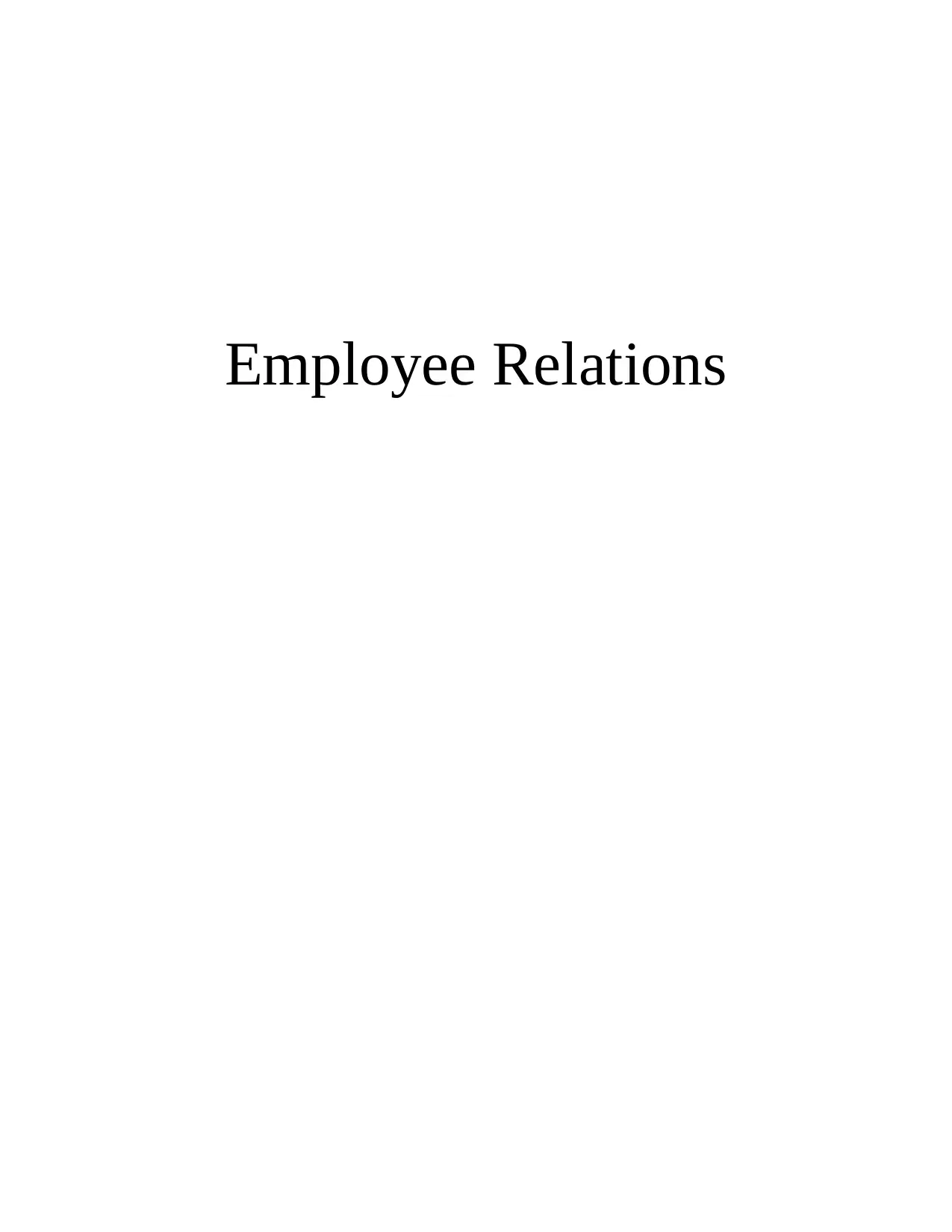
Employee Relations
Paraphrase This Document
Need a fresh take? Get an instant paraphrase of this document with our AI Paraphraser
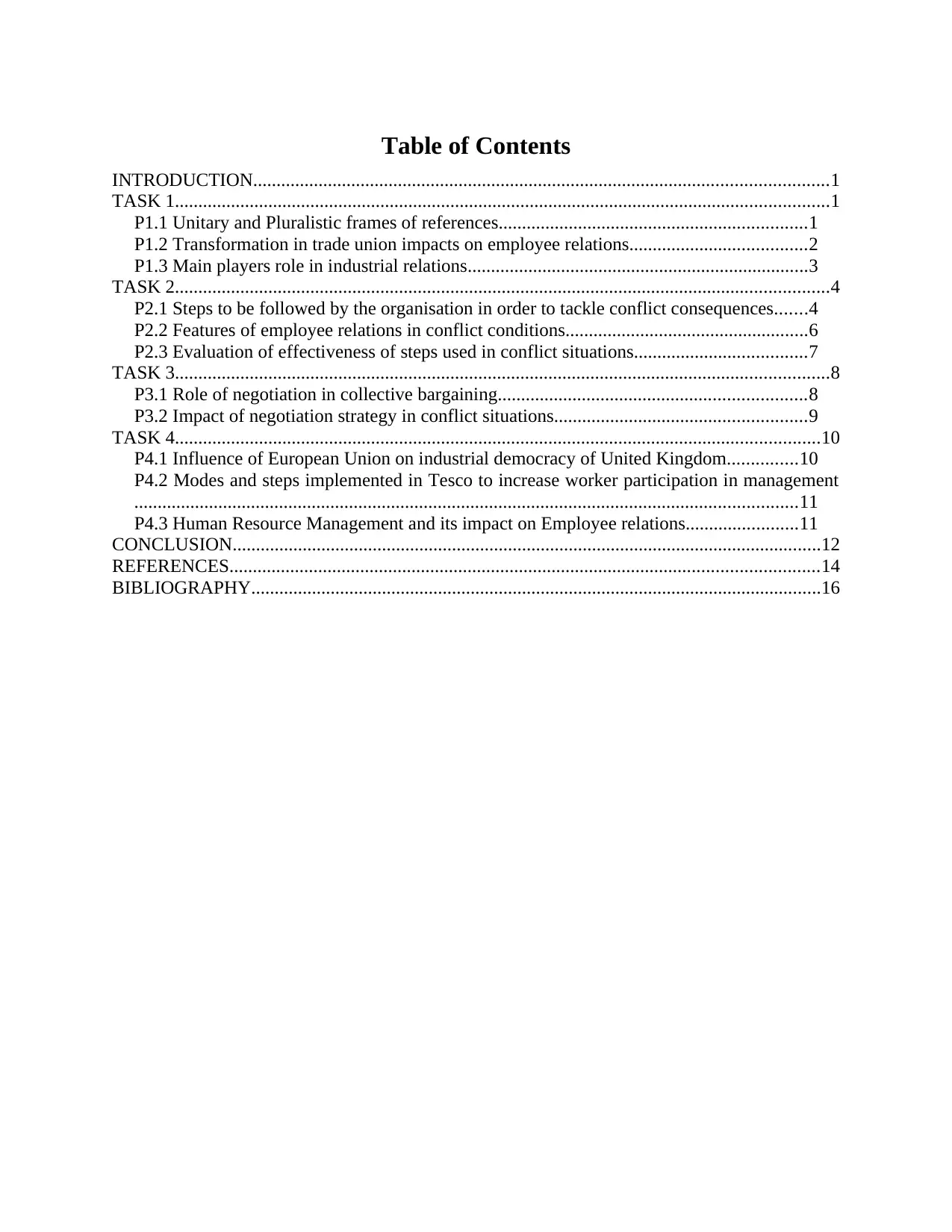
Table of Contents
INTRODUCTION...........................................................................................................................1
TASK 1............................................................................................................................................1
P1.1 Unitary and Pluralistic frames of references..................................................................1
P1.2 Transformation in trade union impacts on employee relations......................................2
P1.3 Main players role in industrial relations.........................................................................3
TASK 2............................................................................................................................................4
P2.1 Steps to be followed by the organisation in order to tackle conflict consequences.......4
P2.2 Features of employee relations in conflict conditions....................................................6
P2.3 Evaluation of effectiveness of steps used in conflict situations.....................................7
TASK 3............................................................................................................................................8
P3.1 Role of negotiation in collective bargaining..................................................................8
P3.2 Impact of negotiation strategy in conflict situations......................................................9
TASK 4..........................................................................................................................................10
P4.1 Influence of European Union on industrial democracy of United Kingdom...............10
P4.2 Modes and steps implemented in Tesco to increase worker participation in management
..............................................................................................................................................11
P4.3 Human Resource Management and its impact on Employee relations........................11
CONCLUSION..............................................................................................................................12
REFERENCES..............................................................................................................................14
BIBLIOGRAPHY..........................................................................................................................16
INTRODUCTION...........................................................................................................................1
TASK 1............................................................................................................................................1
P1.1 Unitary and Pluralistic frames of references..................................................................1
P1.2 Transformation in trade union impacts on employee relations......................................2
P1.3 Main players role in industrial relations.........................................................................3
TASK 2............................................................................................................................................4
P2.1 Steps to be followed by the organisation in order to tackle conflict consequences.......4
P2.2 Features of employee relations in conflict conditions....................................................6
P2.3 Evaluation of effectiveness of steps used in conflict situations.....................................7
TASK 3............................................................................................................................................8
P3.1 Role of negotiation in collective bargaining..................................................................8
P3.2 Impact of negotiation strategy in conflict situations......................................................9
TASK 4..........................................................................................................................................10
P4.1 Influence of European Union on industrial democracy of United Kingdom...............10
P4.2 Modes and steps implemented in Tesco to increase worker participation in management
..............................................................................................................................................11
P4.3 Human Resource Management and its impact on Employee relations........................11
CONCLUSION..............................................................................................................................12
REFERENCES..............................................................................................................................14
BIBLIOGRAPHY..........................................................................................................................16

INTRODUCTION
Employee relations defines the effectiveness in relationship between workers and
employers in an organisation. Healthy relationship in between employees and employers
determines the growth and development of business (Brewster and Hegewisch, 2017). In this
context, HR assistant of Tesco will identify the degree of relationship between employees and
employers working in the organisation. Tesco is one of the largest retail supermarkets in United
Kingdom which employed thousands of employees in their firm. In the present report, unitary
and pluralistic frames of references will be assessed along with evaluating the impact of trade
union on employee relations. Further, the steps which management must follow in order to tackle
conflict situations in organisation will be highlighted. The key features of employee relations in
conflict situation will be evaluated and their effectiveness will be assessed effectively in this
report as well. Moreover, the role of collective bargaining and negotiation along with their
impact on conflict will be identified in this report. Moreover, influence of policies of European
Union on industrial democracy in the United Kingdom will be studied.
TASK 1
P1.1 Unitary and pluralistic frames of references
Unitary Approach
The unitary approach to industrial relations and employee relations is grounded with
mutual cooperation, teamwork, individual treatment and shared goals. It refers to the effective
organisational culture followed in the organisation (Goldthorpe, 2013). In Tesco, there is unitary
approach to industrial relations used by the management effectively and efficiently. In this,
managers visualise conflicts as temporary aberration, resulting from poor management. Both
employees and employers cooperate with each other so that common goals and targets can be
accomplished effectively and efficiently. From the analysis of organisation, it was identified that
disputes and conflicts between unions and managers has been resolved with effective negotiation
and collective bargaining strategy (Geppert, Matten and Williams, 2016). Albeit, many
employees and employers found this approach as seductive, manipulative and exploitative and
which degrades the psychology of employees and employers. Thus, this implies that unitary
approach is the strategy of employee relations in which the employees and employers work in
1
Employee relations defines the effectiveness in relationship between workers and
employers in an organisation. Healthy relationship in between employees and employers
determines the growth and development of business (Brewster and Hegewisch, 2017). In this
context, HR assistant of Tesco will identify the degree of relationship between employees and
employers working in the organisation. Tesco is one of the largest retail supermarkets in United
Kingdom which employed thousands of employees in their firm. In the present report, unitary
and pluralistic frames of references will be assessed along with evaluating the impact of trade
union on employee relations. Further, the steps which management must follow in order to tackle
conflict situations in organisation will be highlighted. The key features of employee relations in
conflict situation will be evaluated and their effectiveness will be assessed effectively in this
report as well. Moreover, the role of collective bargaining and negotiation along with their
impact on conflict will be identified in this report. Moreover, influence of policies of European
Union on industrial democracy in the United Kingdom will be studied.
TASK 1
P1.1 Unitary and pluralistic frames of references
Unitary Approach
The unitary approach to industrial relations and employee relations is grounded with
mutual cooperation, teamwork, individual treatment and shared goals. It refers to the effective
organisational culture followed in the organisation (Goldthorpe, 2013). In Tesco, there is unitary
approach to industrial relations used by the management effectively and efficiently. In this,
managers visualise conflicts as temporary aberration, resulting from poor management. Both
employees and employers cooperate with each other so that common goals and targets can be
accomplished effectively and efficiently. From the analysis of organisation, it was identified that
disputes and conflicts between unions and managers has been resolved with effective negotiation
and collective bargaining strategy (Geppert, Matten and Williams, 2016). Albeit, many
employees and employers found this approach as seductive, manipulative and exploitative and
which degrades the psychology of employees and employers. Thus, this implies that unitary
approach is the strategy of employee relations in which the employees and employers work in
1
⊘ This is a preview!⊘
Do you want full access?
Subscribe today to unlock all pages.

Trusted by 1+ million students worldwide
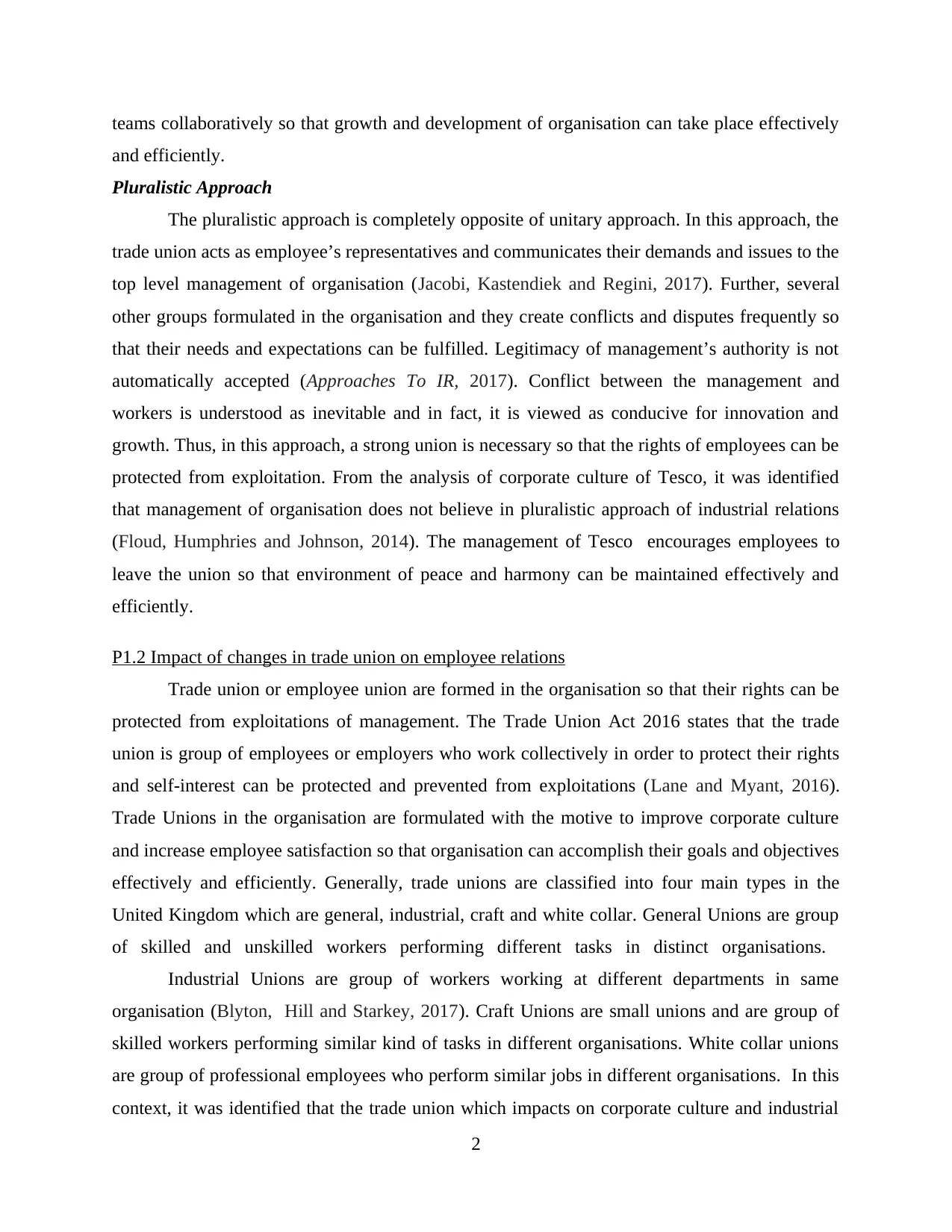
teams collaboratively so that growth and development of organisation can take place effectively
and efficiently.
Pluralistic Approach
The pluralistic approach is completely opposite of unitary approach. In this approach, the
trade union acts as employee’s representatives and communicates their demands and issues to the
top level management of organisation (Jacobi, Kastendiek and Regini, 2017). Further, several
other groups formulated in the organisation and they create conflicts and disputes frequently so
that their needs and expectations can be fulfilled. Legitimacy of management’s authority is not
automatically accepted (Approaches To IR, 2017). Conflict between the management and
workers is understood as inevitable and in fact, it is viewed as conducive for innovation and
growth. Thus, in this approach, a strong union is necessary so that the rights of employees can be
protected from exploitation. From the analysis of corporate culture of Tesco, it was identified
that management of organisation does not believe in pluralistic approach of industrial relations
(Floud, Humphries and Johnson, 2014). The management of Tesco encourages employees to
leave the union so that environment of peace and harmony can be maintained effectively and
efficiently.
P1.2 Impact of changes in trade union on employee relations
Trade union or employee union are formed in the organisation so that their rights can be
protected from exploitations of management. The Trade Union Act 2016 states that the trade
union is group of employees or employers who work collectively in order to protect their rights
and self-interest can be protected and prevented from exploitations (Lane and Myant, 2016).
Trade Unions in the organisation are formulated with the motive to improve corporate culture
and increase employee satisfaction so that organisation can accomplish their goals and objectives
effectively and efficiently. Generally, trade unions are classified into four main types in the
United Kingdom which are general, industrial, craft and white collar. General Unions are group
of skilled and unskilled workers performing different tasks in distinct organisations.
Industrial Unions are group of workers working at different departments in same
organisation (Blyton, Hill and Starkey, 2017). Craft Unions are small unions and are group of
skilled workers performing similar kind of tasks in different organisations. White collar unions
are group of professional employees who perform similar jobs in different organisations. In this
context, it was identified that the trade union which impacts on corporate culture and industrial
2
and efficiently.
Pluralistic Approach
The pluralistic approach is completely opposite of unitary approach. In this approach, the
trade union acts as employee’s representatives and communicates their demands and issues to the
top level management of organisation (Jacobi, Kastendiek and Regini, 2017). Further, several
other groups formulated in the organisation and they create conflicts and disputes frequently so
that their needs and expectations can be fulfilled. Legitimacy of management’s authority is not
automatically accepted (Approaches To IR, 2017). Conflict between the management and
workers is understood as inevitable and in fact, it is viewed as conducive for innovation and
growth. Thus, in this approach, a strong union is necessary so that the rights of employees can be
protected from exploitation. From the analysis of corporate culture of Tesco, it was identified
that management of organisation does not believe in pluralistic approach of industrial relations
(Floud, Humphries and Johnson, 2014). The management of Tesco encourages employees to
leave the union so that environment of peace and harmony can be maintained effectively and
efficiently.
P1.2 Impact of changes in trade union on employee relations
Trade union or employee union are formed in the organisation so that their rights can be
protected from exploitations of management. The Trade Union Act 2016 states that the trade
union is group of employees or employers who work collectively in order to protect their rights
and self-interest can be protected and prevented from exploitations (Lane and Myant, 2016).
Trade Unions in the organisation are formulated with the motive to improve corporate culture
and increase employee satisfaction so that organisation can accomplish their goals and objectives
effectively and efficiently. Generally, trade unions are classified into four main types in the
United Kingdom which are general, industrial, craft and white collar. General Unions are group
of skilled and unskilled workers performing different tasks in distinct organisations.
Industrial Unions are group of workers working at different departments in same
organisation (Blyton, Hill and Starkey, 2017). Craft Unions are small unions and are group of
skilled workers performing similar kind of tasks in different organisations. White collar unions
are group of professional employees who perform similar jobs in different organisations. In this
context, it was identified that the trade union which impacts on corporate culture and industrial
2
Paraphrase This Document
Need a fresh take? Get an instant paraphrase of this document with our AI Paraphraser
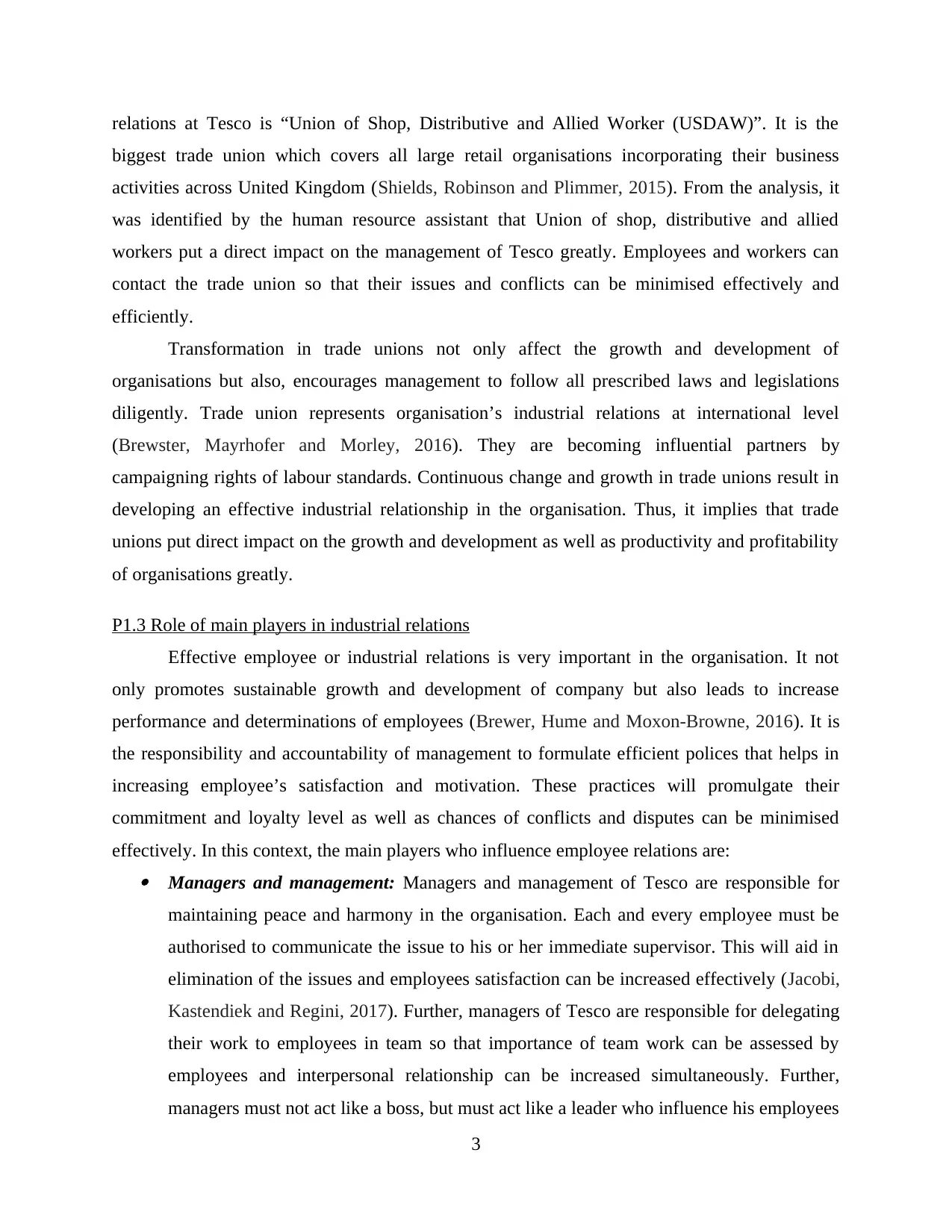
relations at Tesco is “Union of Shop, Distributive and Allied Worker (USDAW)”. It is the
biggest trade union which covers all large retail organisations incorporating their business
activities across United Kingdom (Shields, Robinson and Plimmer, 2015). From the analysis, it
was identified by the human resource assistant that Union of shop, distributive and allied
workers put a direct impact on the management of Tesco greatly. Employees and workers can
contact the trade union so that their issues and conflicts can be minimised effectively and
efficiently.
Transformation in trade unions not only affect the growth and development of
organisations but also, encourages management to follow all prescribed laws and legislations
diligently. Trade union represents organisation’s industrial relations at international level
(Brewster, Mayrhofer and Morley, 2016). They are becoming influential partners by
campaigning rights of labour standards. Continuous change and growth in trade unions result in
developing an effective industrial relationship in the organisation. Thus, it implies that trade
unions put direct impact on the growth and development as well as productivity and profitability
of organisations greatly.
P1.3 Role of main players in industrial relations
Effective employee or industrial relations is very important in the organisation. It not
only promotes sustainable growth and development of company but also leads to increase
performance and determinations of employees (Brewer, Hume and Moxon-Browne, 2016). It is
the responsibility and accountability of management to formulate efficient polices that helps in
increasing employee’s satisfaction and motivation. These practices will promulgate their
commitment and loyalty level as well as chances of conflicts and disputes can be minimised
effectively. In this context, the main players who influence employee relations are: Managers and management: Managers and management of Tesco are responsible for
maintaining peace and harmony in the organisation. Each and every employee must be
authorised to communicate the issue to his or her immediate supervisor. This will aid in
elimination of the issues and employees satisfaction can be increased effectively (Jacobi,
Kastendiek and Regini, 2017). Further, managers of Tesco are responsible for delegating
their work to employees in team so that importance of team work can be assessed by
employees and interpersonal relationship can be increased simultaneously. Further,
managers must not act like a boss, but must act like a leader who influence his employees
3
biggest trade union which covers all large retail organisations incorporating their business
activities across United Kingdom (Shields, Robinson and Plimmer, 2015). From the analysis, it
was identified by the human resource assistant that Union of shop, distributive and allied
workers put a direct impact on the management of Tesco greatly. Employees and workers can
contact the trade union so that their issues and conflicts can be minimised effectively and
efficiently.
Transformation in trade unions not only affect the growth and development of
organisations but also, encourages management to follow all prescribed laws and legislations
diligently. Trade union represents organisation’s industrial relations at international level
(Brewster, Mayrhofer and Morley, 2016). They are becoming influential partners by
campaigning rights of labour standards. Continuous change and growth in trade unions result in
developing an effective industrial relationship in the organisation. Thus, it implies that trade
unions put direct impact on the growth and development as well as productivity and profitability
of organisations greatly.
P1.3 Role of main players in industrial relations
Effective employee or industrial relations is very important in the organisation. It not
only promotes sustainable growth and development of company but also leads to increase
performance and determinations of employees (Brewer, Hume and Moxon-Browne, 2016). It is
the responsibility and accountability of management to formulate efficient polices that helps in
increasing employee’s satisfaction and motivation. These practices will promulgate their
commitment and loyalty level as well as chances of conflicts and disputes can be minimised
effectively. In this context, the main players who influence employee relations are: Managers and management: Managers and management of Tesco are responsible for
maintaining peace and harmony in the organisation. Each and every employee must be
authorised to communicate the issue to his or her immediate supervisor. This will aid in
elimination of the issues and employees satisfaction can be increased effectively (Jacobi,
Kastendiek and Regini, 2017). Further, managers of Tesco are responsible for delegating
their work to employees in team so that importance of team work can be assessed by
employees and interpersonal relationship can be increased simultaneously. Further,
managers must not act like a boss, but must act like a leader who influence his employees
3

on right path and direction so that organisational goals and objectives can be
accomplished efficiently. Trade Unions: Trade unions at Tesco are accountable for articulating the information and
issues faced by employees to the top management of the organisation (Floud, Humphries
and Johnson, 2014). Instead of provoking the issues and difficulties more, they need to
work abreast with management of the organisation so that conflicts and disputes can be
minimised effectively and efficiently. Trade unions are group of employees or employers
who incorporated in the organisation so that the rights of employees or employers can be
protected from exploitations (Lane and Myant, 2016). They must work collaboratively so
that employee welfare in the organisation increase and unfair practices can be obliterated.
Employees: Employees or workers at Tesco are responsible to follow the code of
conducts and ethics formulated by the management of the organisation. In order to
sustain effective relationship and harmony in the organisation employees need to
collaborate with managers and management effectively (Blyton, Hill and Starkey, 2017).
They must not create any unnecessary conflicts and disputes which impact on the
corporation image and reputation and they must follow all the rules and policies
prescribed by the management of the organisation.
TASK 2
P2.1 Steps to be followed by the organisation in order to tackle conflict consequences
Despite having effective corporate governance in Tesco, many a times' organisation faces
conflicts and disputes between employees and employers. Conflicts and disputes minimises the
growth and productivity of the organisation and also diminishes the reputation and goodwill of
the company. Since its inceptions Tesco faced different-different types of conflicts and formulate
various strategies so that conflicts and disputes can be minimised effectively and efficiently
(Shields, Robinson and Plimmer, 2015). In this context the types of conflicts and strategies to
eliminate them is provided below:
Types of Conflicts
1. Interpersonal Conflicts: The conflict situation in which the dispute arises between two
persons whether, employees or employers regarding work culture or work conditions.
4
accomplished efficiently. Trade Unions: Trade unions at Tesco are accountable for articulating the information and
issues faced by employees to the top management of the organisation (Floud, Humphries
and Johnson, 2014). Instead of provoking the issues and difficulties more, they need to
work abreast with management of the organisation so that conflicts and disputes can be
minimised effectively and efficiently. Trade unions are group of employees or employers
who incorporated in the organisation so that the rights of employees or employers can be
protected from exploitations (Lane and Myant, 2016). They must work collaboratively so
that employee welfare in the organisation increase and unfair practices can be obliterated.
Employees: Employees or workers at Tesco are responsible to follow the code of
conducts and ethics formulated by the management of the organisation. In order to
sustain effective relationship and harmony in the organisation employees need to
collaborate with managers and management effectively (Blyton, Hill and Starkey, 2017).
They must not create any unnecessary conflicts and disputes which impact on the
corporation image and reputation and they must follow all the rules and policies
prescribed by the management of the organisation.
TASK 2
P2.1 Steps to be followed by the organisation in order to tackle conflict consequences
Despite having effective corporate governance in Tesco, many a times' organisation faces
conflicts and disputes between employees and employers. Conflicts and disputes minimises the
growth and productivity of the organisation and also diminishes the reputation and goodwill of
the company. Since its inceptions Tesco faced different-different types of conflicts and formulate
various strategies so that conflicts and disputes can be minimised effectively and efficiently
(Shields, Robinson and Plimmer, 2015). In this context the types of conflicts and strategies to
eliminate them is provided below:
Types of Conflicts
1. Interpersonal Conflicts: The conflict situation in which the dispute arises between two
persons whether, employees or employers regarding work culture or work conditions.
4
⊘ This is a preview!⊘
Do you want full access?
Subscribe today to unlock all pages.

Trusted by 1+ million students worldwide

2. Intrapersonal Conflicts: It is based on individual psychology, thoughts and beliefs.
Management of Tesco faced conflict situations where individual become stereotype and
judge other people negatively (Blyton, Hill and Starkey, 2017).
3. Structural Conflicts: The organisation structure influence the structural conflicts. It
depends upon what kind of structure organisation applies.
4. Strategic Conflict: Conflict which arises intentionally by management or an individual
who work together to accomplish goals and objectives (Shields, Robinson and Plimmer,
2015).
Procedures follows by Tesco to eliminate the conflicts
The procedures and steps follows by management of Tesco to eliminate conflicts are
provided below:
Compromising: Compromising is the win-win approach used by the management
of Tesco. They consider some of the demands and expectations of affected parties
and consider some of the management demands.
Avoiding: Many a time, management does not consider some conflicts as a big
issues and eschew them. They wait for the time and the dispute automatically
perished (Brewster, Mayrhofer and Morley, 2016). Though it is a risky approach
but work efficiently some times.
Accommodating: In accommodating approach managers of Tesco aims to resolve
the conflicts by considering employees needs first. This aid in increasing morale
and motivation in employees and conflict eliminate effectively.
5
Illustration 1: Conflict Management Model
(Source: Chand, S., 2015)
Management of Tesco faced conflict situations where individual become stereotype and
judge other people negatively (Blyton, Hill and Starkey, 2017).
3. Structural Conflicts: The organisation structure influence the structural conflicts. It
depends upon what kind of structure organisation applies.
4. Strategic Conflict: Conflict which arises intentionally by management or an individual
who work together to accomplish goals and objectives (Shields, Robinson and Plimmer,
2015).
Procedures follows by Tesco to eliminate the conflicts
The procedures and steps follows by management of Tesco to eliminate conflicts are
provided below:
Compromising: Compromising is the win-win approach used by the management
of Tesco. They consider some of the demands and expectations of affected parties
and consider some of the management demands.
Avoiding: Many a time, management does not consider some conflicts as a big
issues and eschew them. They wait for the time and the dispute automatically
perished (Brewster, Mayrhofer and Morley, 2016). Though it is a risky approach
but work efficiently some times.
Accommodating: In accommodating approach managers of Tesco aims to resolve
the conflicts by considering employees needs first. This aid in increasing morale
and motivation in employees and conflict eliminate effectively.
5
Illustration 1: Conflict Management Model
(Source: Chand, S., 2015)
Paraphrase This Document
Need a fresh take? Get an instant paraphrase of this document with our AI Paraphraser
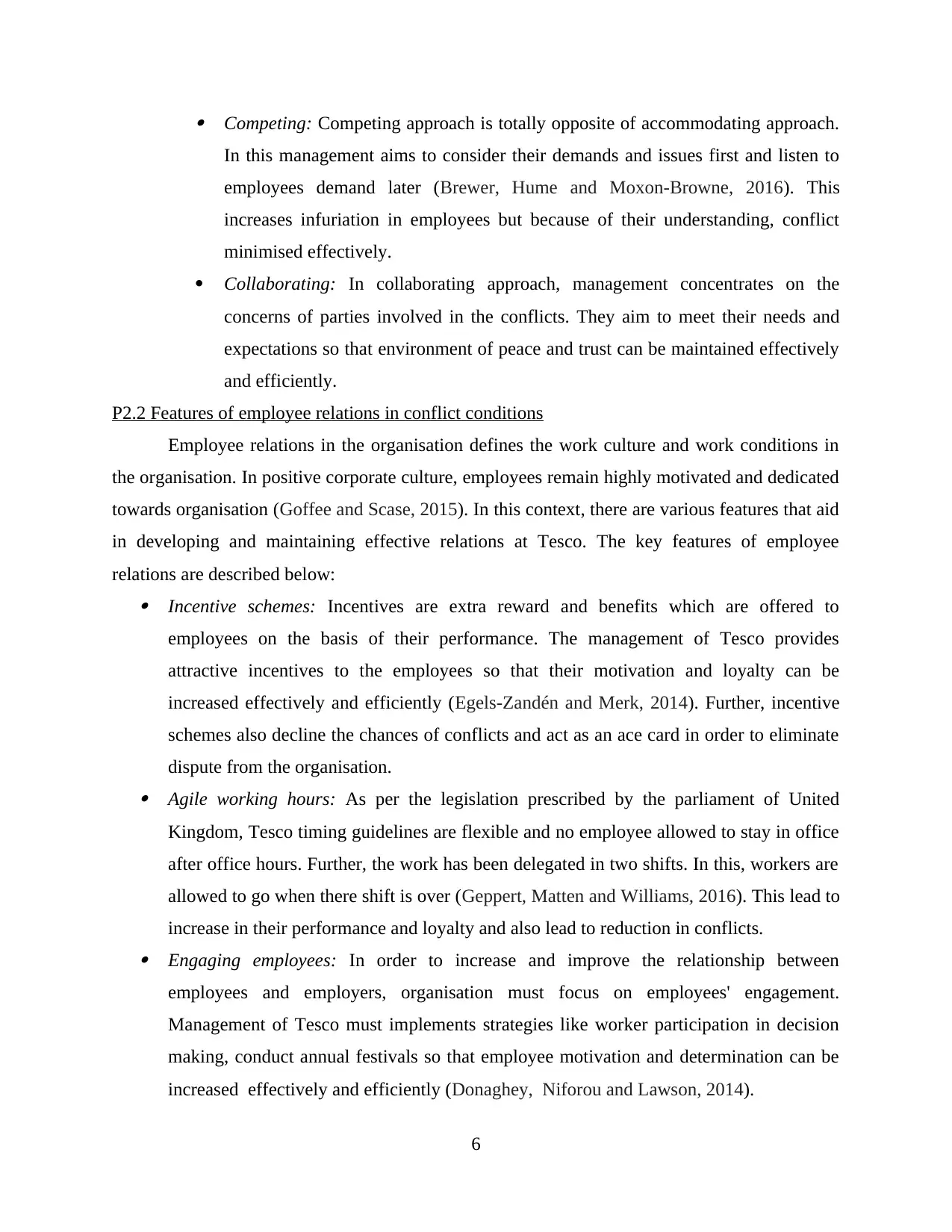
Competing: Competing approach is totally opposite of accommodating approach.
In this management aims to consider their demands and issues first and listen to
employees demand later (Brewer, Hume and Moxon-Browne, 2016). This
increases infuriation in employees but because of their understanding, conflict
minimised effectively.
Collaborating: In collaborating approach, management concentrates on the
concerns of parties involved in the conflicts. They aim to meet their needs and
expectations so that environment of peace and trust can be maintained effectively
and efficiently.
P2.2 Features of employee relations in conflict conditions
Employee relations in the organisation defines the work culture and work conditions in
the organisation. In positive corporate culture, employees remain highly motivated and dedicated
towards organisation (Goffee and Scase, 2015). In this context, there are various features that aid
in developing and maintaining effective relations at Tesco. The key features of employee
relations are described below: Incentive schemes: Incentives are extra reward and benefits which are offered to
employees on the basis of their performance. The management of Tesco provides
attractive incentives to the employees so that their motivation and loyalty can be
increased effectively and efficiently (Egels-Zandén and Merk, 2014). Further, incentive
schemes also decline the chances of conflicts and act as an ace card in order to eliminate
dispute from the organisation. Agile working hours: As per the legislation prescribed by the parliament of United
Kingdom, Tesco timing guidelines are flexible and no employee allowed to stay in office
after office hours. Further, the work has been delegated in two shifts. In this, workers are
allowed to go when there shift is over (Geppert, Matten and Williams, 2016). This lead to
increase in their performance and loyalty and also lead to reduction in conflicts. Engaging employees: In order to increase and improve the relationship between
employees and employers, organisation must focus on employees' engagement.
Management of Tesco must implements strategies like worker participation in decision
making, conduct annual festivals so that employee motivation and determination can be
increased effectively and efficiently (Donaghey, Niforou and Lawson, 2014).
6
In this management aims to consider their demands and issues first and listen to
employees demand later (Brewer, Hume and Moxon-Browne, 2016). This
increases infuriation in employees but because of their understanding, conflict
minimised effectively.
Collaborating: In collaborating approach, management concentrates on the
concerns of parties involved in the conflicts. They aim to meet their needs and
expectations so that environment of peace and trust can be maintained effectively
and efficiently.
P2.2 Features of employee relations in conflict conditions
Employee relations in the organisation defines the work culture and work conditions in
the organisation. In positive corporate culture, employees remain highly motivated and dedicated
towards organisation (Goffee and Scase, 2015). In this context, there are various features that aid
in developing and maintaining effective relations at Tesco. The key features of employee
relations are described below: Incentive schemes: Incentives are extra reward and benefits which are offered to
employees on the basis of their performance. The management of Tesco provides
attractive incentives to the employees so that their motivation and loyalty can be
increased effectively and efficiently (Egels-Zandén and Merk, 2014). Further, incentive
schemes also decline the chances of conflicts and act as an ace card in order to eliminate
dispute from the organisation. Agile working hours: As per the legislation prescribed by the parliament of United
Kingdom, Tesco timing guidelines are flexible and no employee allowed to stay in office
after office hours. Further, the work has been delegated in two shifts. In this, workers are
allowed to go when there shift is over (Geppert, Matten and Williams, 2016). This lead to
increase in their performance and loyalty and also lead to reduction in conflicts. Engaging employees: In order to increase and improve the relationship between
employees and employers, organisation must focus on employees' engagement.
Management of Tesco must implements strategies like worker participation in decision
making, conduct annual festivals so that employee motivation and determination can be
increased effectively and efficiently (Donaghey, Niforou and Lawson, 2014).
6
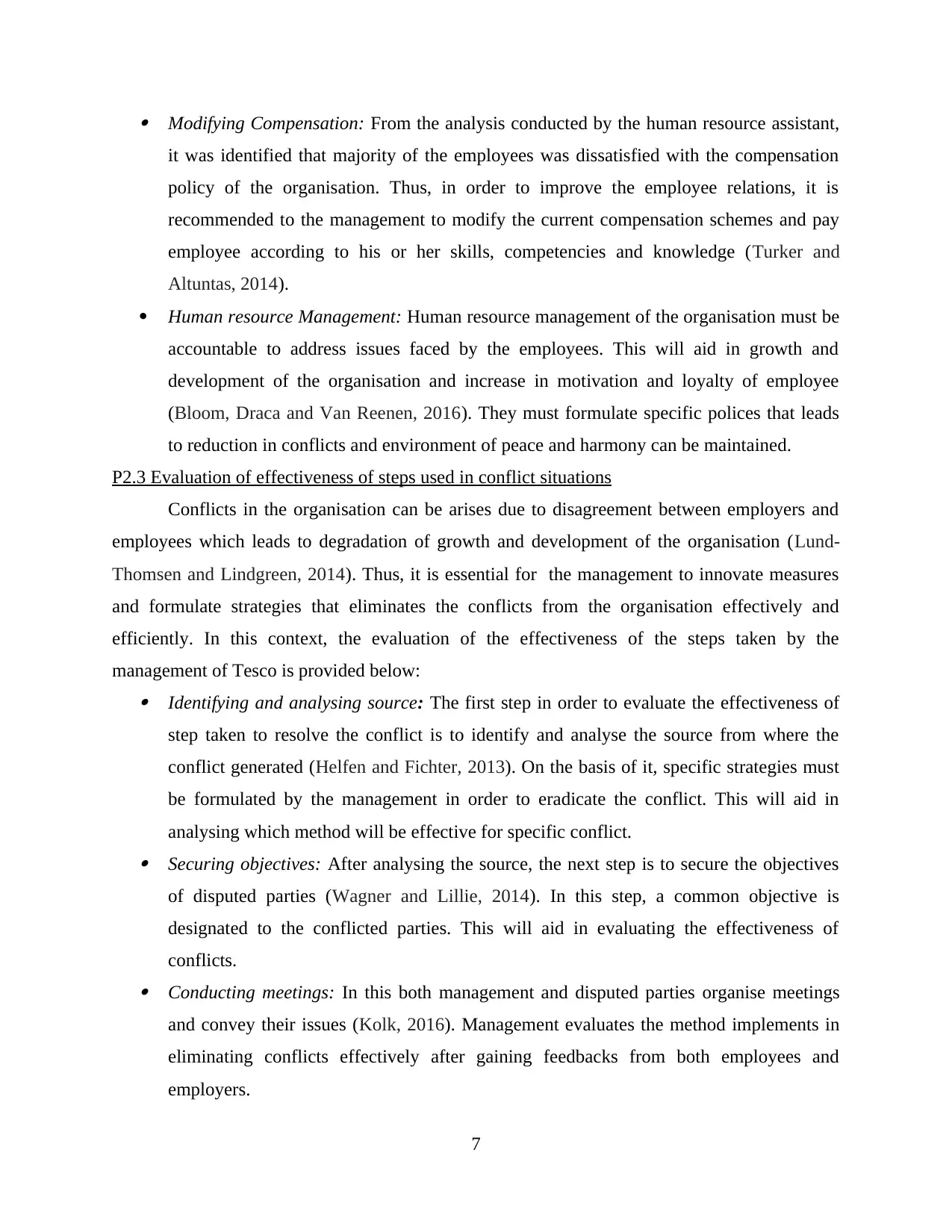
Modifying Compensation: From the analysis conducted by the human resource assistant,
it was identified that majority of the employees was dissatisfied with the compensation
policy of the organisation. Thus, in order to improve the employee relations, it is
recommended to the management to modify the current compensation schemes and pay
employee according to his or her skills, competencies and knowledge (Turker and
Altuntas, 2014).
Human resource Management: Human resource management of the organisation must be
accountable to address issues faced by the employees. This will aid in growth and
development of the organisation and increase in motivation and loyalty of employee
(Bloom, Draca and Van Reenen, 2016). They must formulate specific polices that leads
to reduction in conflicts and environment of peace and harmony can be maintained.
P2.3 Evaluation of effectiveness of steps used in conflict situations
Conflicts in the organisation can be arises due to disagreement between employers and
employees which leads to degradation of growth and development of the organisation (Lund-
Thomsen and Lindgreen, 2014). Thus, it is essential for the management to innovate measures
and formulate strategies that eliminates the conflicts from the organisation effectively and
efficiently. In this context, the evaluation of the effectiveness of the steps taken by the
management of Tesco is provided below: Identifying and analysing source: The first step in order to evaluate the effectiveness of
step taken to resolve the conflict is to identify and analyse the source from where the
conflict generated (Helfen and Fichter, 2013). On the basis of it, specific strategies must
be formulated by the management in order to eradicate the conflict. This will aid in
analysing which method will be effective for specific conflict. Securing objectives: After analysing the source, the next step is to secure the objectives
of disputed parties (Wagner and Lillie, 2014). In this step, a common objective is
designated to the conflicted parties. This will aid in evaluating the effectiveness of
conflicts. Conducting meetings: In this both management and disputed parties organise meetings
and convey their issues (Kolk, 2016). Management evaluates the method implements in
eliminating conflicts effectively after gaining feedbacks from both employees and
employers.
7
it was identified that majority of the employees was dissatisfied with the compensation
policy of the organisation. Thus, in order to improve the employee relations, it is
recommended to the management to modify the current compensation schemes and pay
employee according to his or her skills, competencies and knowledge (Turker and
Altuntas, 2014).
Human resource Management: Human resource management of the organisation must be
accountable to address issues faced by the employees. This will aid in growth and
development of the organisation and increase in motivation and loyalty of employee
(Bloom, Draca and Van Reenen, 2016). They must formulate specific polices that leads
to reduction in conflicts and environment of peace and harmony can be maintained.
P2.3 Evaluation of effectiveness of steps used in conflict situations
Conflicts in the organisation can be arises due to disagreement between employers and
employees which leads to degradation of growth and development of the organisation (Lund-
Thomsen and Lindgreen, 2014). Thus, it is essential for the management to innovate measures
and formulate strategies that eliminates the conflicts from the organisation effectively and
efficiently. In this context, the evaluation of the effectiveness of the steps taken by the
management of Tesco is provided below: Identifying and analysing source: The first step in order to evaluate the effectiveness of
step taken to resolve the conflict is to identify and analyse the source from where the
conflict generated (Helfen and Fichter, 2013). On the basis of it, specific strategies must
be formulated by the management in order to eradicate the conflict. This will aid in
analysing which method will be effective for specific conflict. Securing objectives: After analysing the source, the next step is to secure the objectives
of disputed parties (Wagner and Lillie, 2014). In this step, a common objective is
designated to the conflicted parties. This will aid in evaluating the effectiveness of
conflicts. Conducting meetings: In this both management and disputed parties organise meetings
and convey their issues (Kolk, 2016). Management evaluates the method implements in
eliminating conflicts effectively after gaining feedbacks from both employees and
employers.
7
⊘ This is a preview!⊘
Do you want full access?
Subscribe today to unlock all pages.

Trusted by 1+ million students worldwide
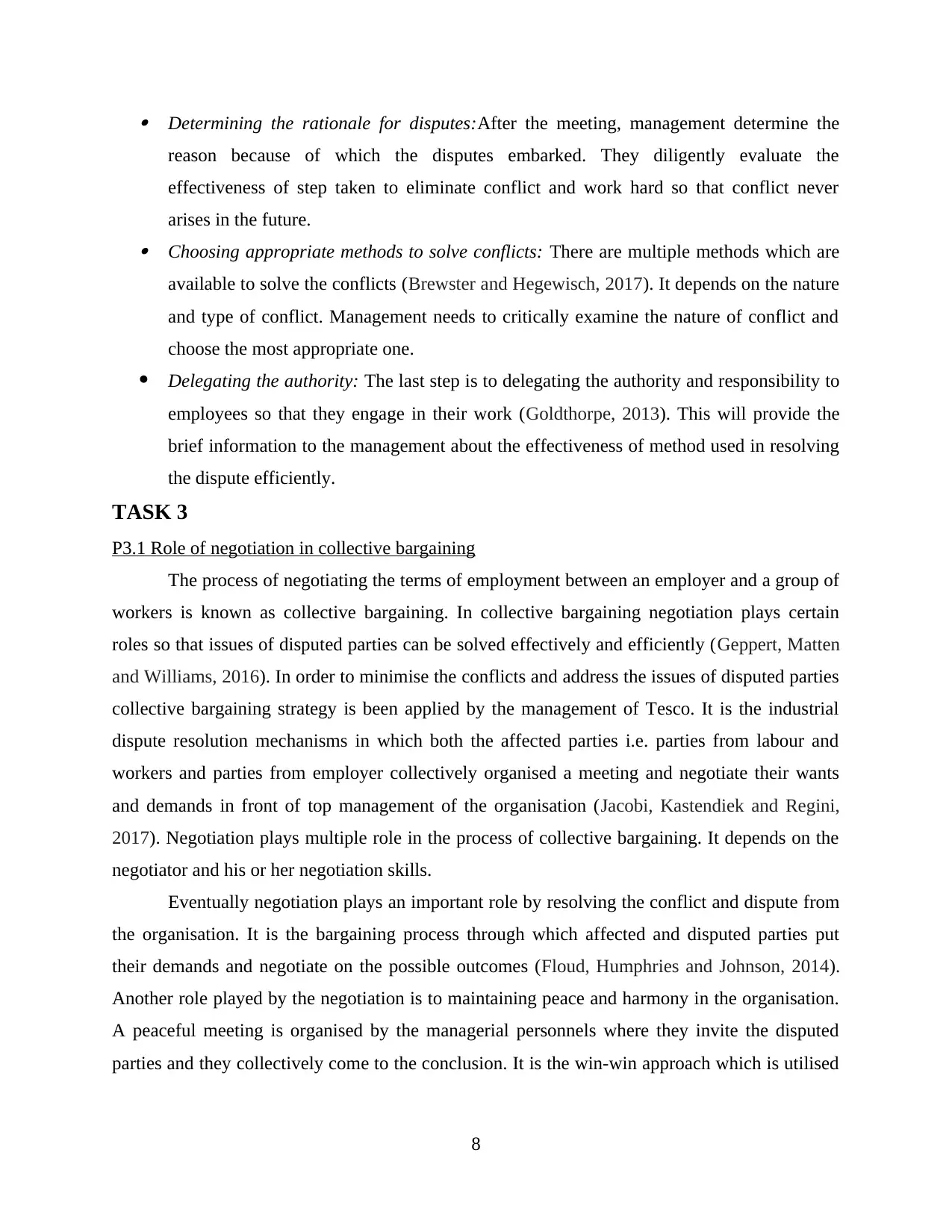
Determining the rationale for disputes:After the meeting, management determine the
reason because of which the disputes embarked. They diligently evaluate the
effectiveness of step taken to eliminate conflict and work hard so that conflict never
arises in the future. Choosing appropriate methods to solve conflicts: There are multiple methods which are
available to solve the conflicts (Brewster and Hegewisch, 2017). It depends on the nature
and type of conflict. Management needs to critically examine the nature of conflict and
choose the most appropriate one.
Delegating the authority: The last step is to delegating the authority and responsibility to
employees so that they engage in their work (Goldthorpe, 2013). This will provide the
brief information to the management about the effectiveness of method used in resolving
the dispute efficiently.
TASK 3
P3.1 Role of negotiation in collective bargaining
The process of negotiating the terms of employment between an employer and a group of
workers is known as collective bargaining. In collective bargaining negotiation plays certain
roles so that issues of disputed parties can be solved effectively and efficiently (Geppert, Matten
and Williams, 2016). In order to minimise the conflicts and address the issues of disputed parties
collective bargaining strategy is been applied by the management of Tesco. It is the industrial
dispute resolution mechanisms in which both the affected parties i.e. parties from labour and
workers and parties from employer collectively organised a meeting and negotiate their wants
and demands in front of top management of the organisation (Jacobi, Kastendiek and Regini,
2017). Negotiation plays multiple role in the process of collective bargaining. It depends on the
negotiator and his or her negotiation skills.
Eventually negotiation plays an important role by resolving the conflict and dispute from
the organisation. It is the bargaining process through which affected and disputed parties put
their demands and negotiate on the possible outcomes (Floud, Humphries and Johnson, 2014).
Another role played by the negotiation is to maintaining peace and harmony in the organisation.
A peaceful meeting is organised by the managerial personnels where they invite the disputed
parties and they collectively come to the conclusion. It is the win-win approach which is utilised
8
reason because of which the disputes embarked. They diligently evaluate the
effectiveness of step taken to eliminate conflict and work hard so that conflict never
arises in the future. Choosing appropriate methods to solve conflicts: There are multiple methods which are
available to solve the conflicts (Brewster and Hegewisch, 2017). It depends on the nature
and type of conflict. Management needs to critically examine the nature of conflict and
choose the most appropriate one.
Delegating the authority: The last step is to delegating the authority and responsibility to
employees so that they engage in their work (Goldthorpe, 2013). This will provide the
brief information to the management about the effectiveness of method used in resolving
the dispute efficiently.
TASK 3
P3.1 Role of negotiation in collective bargaining
The process of negotiating the terms of employment between an employer and a group of
workers is known as collective bargaining. In collective bargaining negotiation plays certain
roles so that issues of disputed parties can be solved effectively and efficiently (Geppert, Matten
and Williams, 2016). In order to minimise the conflicts and address the issues of disputed parties
collective bargaining strategy is been applied by the management of Tesco. It is the industrial
dispute resolution mechanisms in which both the affected parties i.e. parties from labour and
workers and parties from employer collectively organised a meeting and negotiate their wants
and demands in front of top management of the organisation (Jacobi, Kastendiek and Regini,
2017). Negotiation plays multiple role in the process of collective bargaining. It depends on the
negotiator and his or her negotiation skills.
Eventually negotiation plays an important role by resolving the conflict and dispute from
the organisation. It is the bargaining process through which affected and disputed parties put
their demands and negotiate on the possible outcomes (Floud, Humphries and Johnson, 2014).
Another role played by the negotiation is to maintaining peace and harmony in the organisation.
A peaceful meeting is organised by the managerial personnels where they invite the disputed
parties and they collectively come to the conclusion. It is the win-win approach which is utilised
8
Paraphrase This Document
Need a fresh take? Get an instant paraphrase of this document with our AI Paraphraser
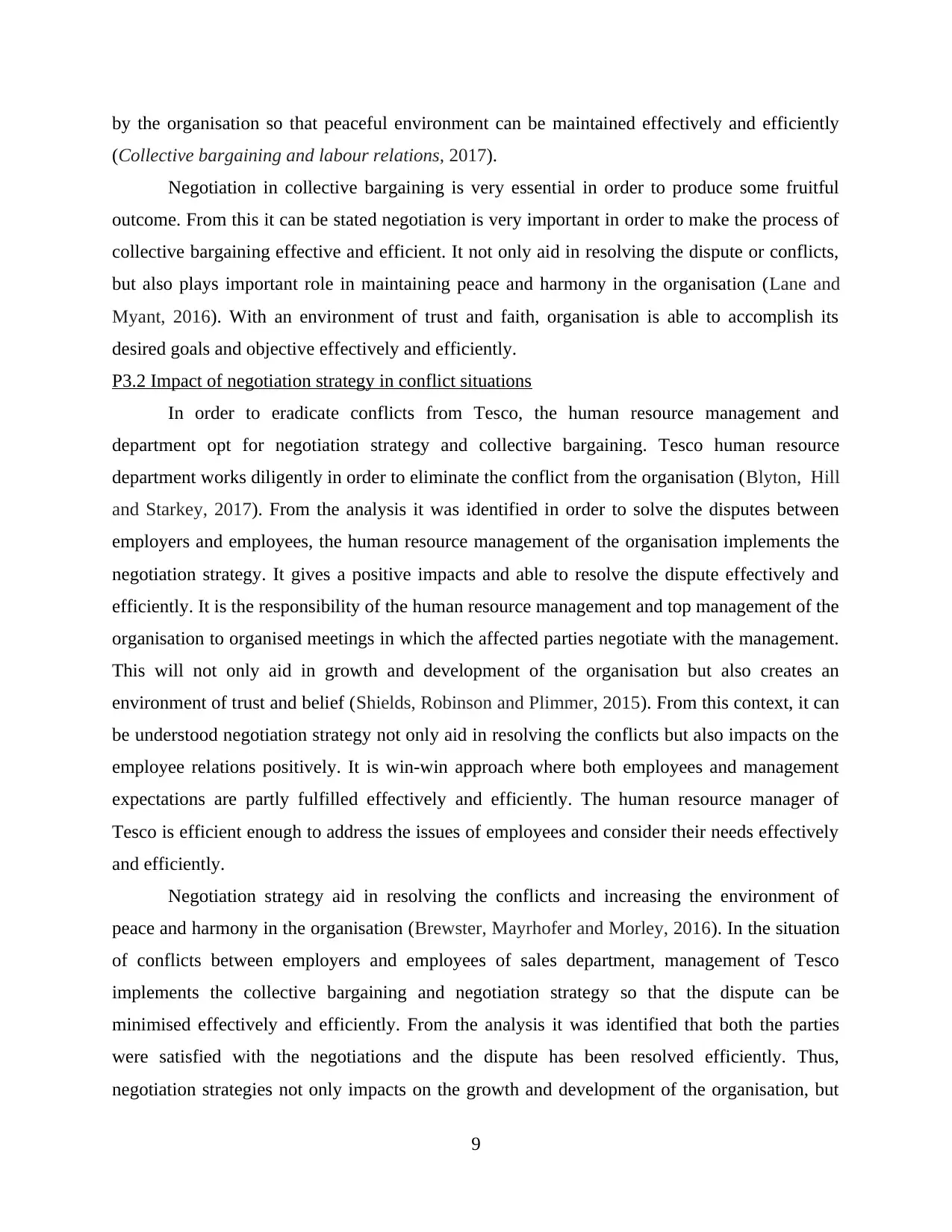
by the organisation so that peaceful environment can be maintained effectively and efficiently
(Collective bargaining and labour relations, 2017).
Negotiation in collective bargaining is very essential in order to produce some fruitful
outcome. From this it can be stated negotiation is very important in order to make the process of
collective bargaining effective and efficient. It not only aid in resolving the dispute or conflicts,
but also plays important role in maintaining peace and harmony in the organisation (Lane and
Myant, 2016). With an environment of trust and faith, organisation is able to accomplish its
desired goals and objective effectively and efficiently.
P3.2 Impact of negotiation strategy in conflict situations
In order to eradicate conflicts from Tesco, the human resource management and
department opt for negotiation strategy and collective bargaining. Tesco human resource
department works diligently in order to eliminate the conflict from the organisation (Blyton, Hill
and Starkey, 2017). From the analysis it was identified in order to solve the disputes between
employers and employees, the human resource management of the organisation implements the
negotiation strategy. It gives a positive impacts and able to resolve the dispute effectively and
efficiently. It is the responsibility of the human resource management and top management of the
organisation to organised meetings in which the affected parties negotiate with the management.
This will not only aid in growth and development of the organisation but also creates an
environment of trust and belief (Shields, Robinson and Plimmer, 2015). From this context, it can
be understood negotiation strategy not only aid in resolving the conflicts but also impacts on the
employee relations positively. It is win-win approach where both employees and management
expectations are partly fulfilled effectively and efficiently. The human resource manager of
Tesco is efficient enough to address the issues of employees and consider their needs effectively
and efficiently.
Negotiation strategy aid in resolving the conflicts and increasing the environment of
peace and harmony in the organisation (Brewster, Mayrhofer and Morley, 2016). In the situation
of conflicts between employers and employees of sales department, management of Tesco
implements the collective bargaining and negotiation strategy so that the dispute can be
minimised effectively and efficiently. From the analysis it was identified that both the parties
were satisfied with the negotiations and the dispute has been resolved efficiently. Thus,
negotiation strategies not only impacts on the growth and development of the organisation, but
9
(Collective bargaining and labour relations, 2017).
Negotiation in collective bargaining is very essential in order to produce some fruitful
outcome. From this it can be stated negotiation is very important in order to make the process of
collective bargaining effective and efficient. It not only aid in resolving the dispute or conflicts,
but also plays important role in maintaining peace and harmony in the organisation (Lane and
Myant, 2016). With an environment of trust and faith, organisation is able to accomplish its
desired goals and objective effectively and efficiently.
P3.2 Impact of negotiation strategy in conflict situations
In order to eradicate conflicts from Tesco, the human resource management and
department opt for negotiation strategy and collective bargaining. Tesco human resource
department works diligently in order to eliminate the conflict from the organisation (Blyton, Hill
and Starkey, 2017). From the analysis it was identified in order to solve the disputes between
employers and employees, the human resource management of the organisation implements the
negotiation strategy. It gives a positive impacts and able to resolve the dispute effectively and
efficiently. It is the responsibility of the human resource management and top management of the
organisation to organised meetings in which the affected parties negotiate with the management.
This will not only aid in growth and development of the organisation but also creates an
environment of trust and belief (Shields, Robinson and Plimmer, 2015). From this context, it can
be understood negotiation strategy not only aid in resolving the conflicts but also impacts on the
employee relations positively. It is win-win approach where both employees and management
expectations are partly fulfilled effectively and efficiently. The human resource manager of
Tesco is efficient enough to address the issues of employees and consider their needs effectively
and efficiently.
Negotiation strategy aid in resolving the conflicts and increasing the environment of
peace and harmony in the organisation (Brewster, Mayrhofer and Morley, 2016). In the situation
of conflicts between employers and employees of sales department, management of Tesco
implements the collective bargaining and negotiation strategy so that the dispute can be
minimised effectively and efficiently. From the analysis it was identified that both the parties
were satisfied with the negotiations and the dispute has been resolved efficiently. Thus,
negotiation strategies not only impacts on the growth and development of the organisation, but
9

also aid in resolving disputes and disparities from the organisation (Brewer, Hume and Moxon-
Browne, 2016).
TASK 4
P4.1 Influence of European Union on industrial democracy of United Kingdom
Industrial democracy is an arrangement which involves workers making decisions,
sharing responsibility and authority in the workplace. European Union policies and legislation
impacts on the industrial democracy of United Kingdom. The legislation encourages a much
more prominent role for employee in the organisation decision making process. The legislation
allows the employees to participate in the decision making process (Goffee and Scase, 2015).
The European Union policies mandates that business corporates must encourages worker
participation in the management. It not only aids in incorporation of new and unique idea in the
organisation but also provide benchmark and frameworks to employee to boost their motivation
and performance levels. The policy of European Unions influences the industrial democracy of
United Kingdom greatly and explicitly (Egels-Zandén and Merk, 2014Geppert, Matten and
Williams, 2016). The legislation formulated and implemented by the European Union must be
followed by the organisation operating in United Kingdom. This include Tesco and other
multinational organisations. Further, transformations in the policies impacts on the functions of
organisations.
Due to the influence of European Union, the new partner based relationship that
encourages both workers and management to work as a team exists in British Industry
(Donaghey, Niforou and Lawson, 2014). Further, now unions perceived as the institution that
work collaboratively with the management of the organisation to educate the workers and
employees and delivering them knowledge about employee legislation and their rights. This aid
in improving their knowledge and workers now becoming self determine and more committed
towards organisation. Council has been established as per the guide lines of European Union that
act as representatives of all department in the organisation. The role designated to the work
council is to formulate long term goals and objectives of the business and to implement certain
strategies in order to improve the anticipated prospectus of the business organisation effectively
and efficiently. The European Union Policy also formulate worker shareholder and worker
partner who have share in the ownership of the company (Turker and Altuntas, 2014). Thus, it
implies that the policies and legislation formulated in European countries and Union impact on
10
Browne, 2016).
TASK 4
P4.1 Influence of European Union on industrial democracy of United Kingdom
Industrial democracy is an arrangement which involves workers making decisions,
sharing responsibility and authority in the workplace. European Union policies and legislation
impacts on the industrial democracy of United Kingdom. The legislation encourages a much
more prominent role for employee in the organisation decision making process. The legislation
allows the employees to participate in the decision making process (Goffee and Scase, 2015).
The European Union policies mandates that business corporates must encourages worker
participation in the management. It not only aids in incorporation of new and unique idea in the
organisation but also provide benchmark and frameworks to employee to boost their motivation
and performance levels. The policy of European Unions influences the industrial democracy of
United Kingdom greatly and explicitly (Egels-Zandén and Merk, 2014Geppert, Matten and
Williams, 2016). The legislation formulated and implemented by the European Union must be
followed by the organisation operating in United Kingdom. This include Tesco and other
multinational organisations. Further, transformations in the policies impacts on the functions of
organisations.
Due to the influence of European Union, the new partner based relationship that
encourages both workers and management to work as a team exists in British Industry
(Donaghey, Niforou and Lawson, 2014). Further, now unions perceived as the institution that
work collaboratively with the management of the organisation to educate the workers and
employees and delivering them knowledge about employee legislation and their rights. This aid
in improving their knowledge and workers now becoming self determine and more committed
towards organisation. Council has been established as per the guide lines of European Union that
act as representatives of all department in the organisation. The role designated to the work
council is to formulate long term goals and objectives of the business and to implement certain
strategies in order to improve the anticipated prospectus of the business organisation effectively
and efficiently. The European Union Policy also formulate worker shareholder and worker
partner who have share in the ownership of the company (Turker and Altuntas, 2014). Thus, it
implies that the policies and legislation formulated in European countries and Union impact on
10
⊘ This is a preview!⊘
Do you want full access?
Subscribe today to unlock all pages.

Trusted by 1+ million students worldwide
1 out of 18
Related Documents
Your All-in-One AI-Powered Toolkit for Academic Success.
+13062052269
info@desklib.com
Available 24*7 on WhatsApp / Email
![[object Object]](/_next/static/media/star-bottom.7253800d.svg)
Unlock your academic potential
Copyright © 2020–2025 A2Z Services. All Rights Reserved. Developed and managed by ZUCOL.





